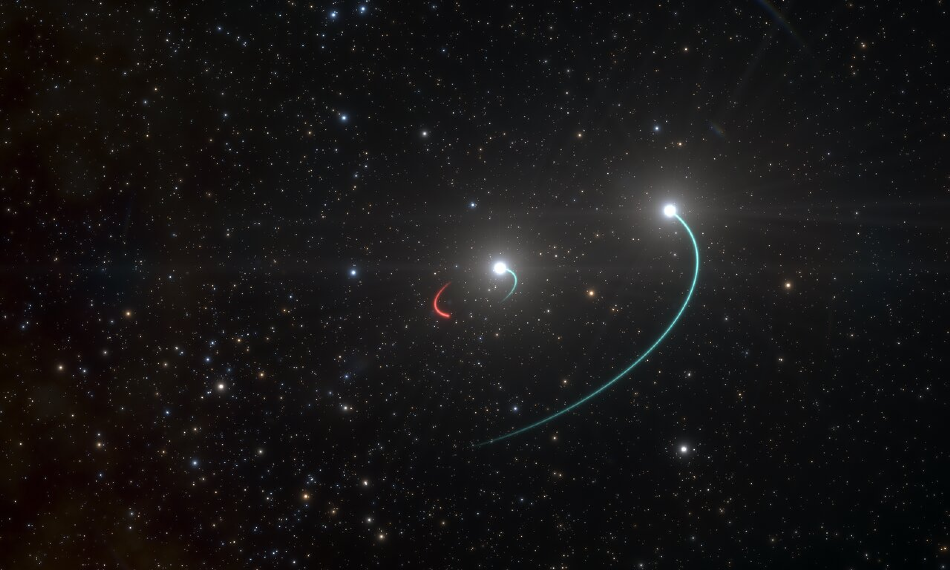May 7 2020
A black hole located only 1000 light-years from Earth has been discovered by a group of astronomers from the European Southern Observatory (ESO) and other institutes.
 Artist’s impression of the triple system with the closest black hole. Image Credit: ESO/L. Calçada.
Artist’s impression of the triple system with the closest black hole. Image Credit: ESO/L. Calçada.
The black hole is situated closer to the Solar System than any other identified so far. It is also part of a triple system, named HR 6819, that can be observed with the naked eye. Evidence for the invisible object was obtained by the researchers by monitoring two of its companion stars with the help of the MPG/ESO 2.2-m telescope at ESO’s La Silla Observatory in Chile.
According to them, this system could be the tip of the iceberg, and many such black holes could be discovered in the future.
We were totally surprised when we realised that this is the first stellar system with a black hole that can be seen with the unaided eye.
Petr Hadrava, Study Co-Author and Emeritus Scientist, Academy of Sciences of the Czech Republic
The system is situated in the constellation of Telescopium and very close to Earth that, on a dark, clear night, its stars can be observed from the southern hemisphere without binoculars or a telescope. According to ESO scientist Thomas Rivinius who led the study published recently in Astronomy & Astrophysics, “This system contains the nearest black hole to Earth that we know of.”
The researchers initially observed the HR 6819 system as part of a study of double-star systems. But an analysis of the observations left them startled, with the spotting of a third, previously undiscovered body in HR 6819—a black hole.
Observations using the FEROS spectrograph on the MPG/ESO 2.2-m telescope at La Silla revealed that one of the two visible stars orbits an unidentified object every 40 days, and that the second star is located further away from this inner pair.
The observations needed to determine the period of 40 days had to be spread over several months. This was only possible thanks to ESO’s pioneering service-observing scheme under which observations are made by ESO staff on behalf of the scientists needing them.
Dietrich Baade, Study Co-Author and Emeritus Astronomer, ESO
The enigmatic black hole in HR 6819 is one of the first stellar-mass black holes identified not to interact violently with their environment and, hence, seem truly black. However, the researchers were able to identify its presence and calculate its mass by analyzing the star’s orbit in the inner pair. “An invisible object with a mass at least 4 times that of the Sun can only be a black hole,” notes Rivinius, who is based in Chile.
Astronomers have been able to find only two dozen black holes in the Milky Way galaxy so far, and almost all of those exhibit strong interactions with their environment and reveal their presence by emitting strong X-rays during this interaction.
However, researchers predict that, throughout the lifetime of the Milky Way, many more stars collapsed into black holes at the end of their lives. The finding of an invisible, silent black hole in HR 6819 offers hints about the whereabouts of several enigmatic black holes in the Milky Way.
“There must be hundreds of millions of black holes out there, but we know about only very few. Knowing what to look for should put us in a better position to find them,” stated Rivinius. According to Baade, the discovery of a black hole in a triple system very close to Earth suggests that researchers are observing only “the tip of an exciting iceberg.”
Astronomers are hopeful that the discovery could shed some light on a second system. “We realised that another system, called LB-1, may also be such a triple, though we’d need more observations to say for sure,” stated Marianne Heida, co-author of the paper who is a postdoctoral fellow at ESO.
LB-1 is a bit further away from Earth but still pretty close in astronomical terms, so that means that probably many more of these systems exist. By finding and studying them we can learn a lot about the formation and evolution of those rare stars that begin their lives with more than about 8 times the mass of the Sun and end them in a supernova explosion that leaves behind a black hole.
Marianne Heida, Study Co-Author and Postdoctoral Fellow, ESO
Moreover, the finding of these triple systems with a faraway star and an inner pair could offer clues about the violent cosmic mergers that emit gravitational waves strong enough to be detected from Earth. Some of the astronomers hope that the mergers could occur in systems with a configuration analogous to HR 6819 or LB-1, but where the inner pair is composed of either two black holes or a neutron star and a black hole.
The faraway outer object could exert a gravitational effect on the inner pair such that it activates a merger and the discharge of gravitational waves. Both HR 6819 and LB-1 include only one black hole and no neutron stars, but these systems could be useful to understand how stellar collisions can occur in triple star systems.
Journal Reference:
Rivinius, Th., et al. (2020) A naked-eye triple system with a nonaccreting black hole in the inner binary. Astronomy & Astrophysics. doi.org/10.1051/0004-6361/202038020.